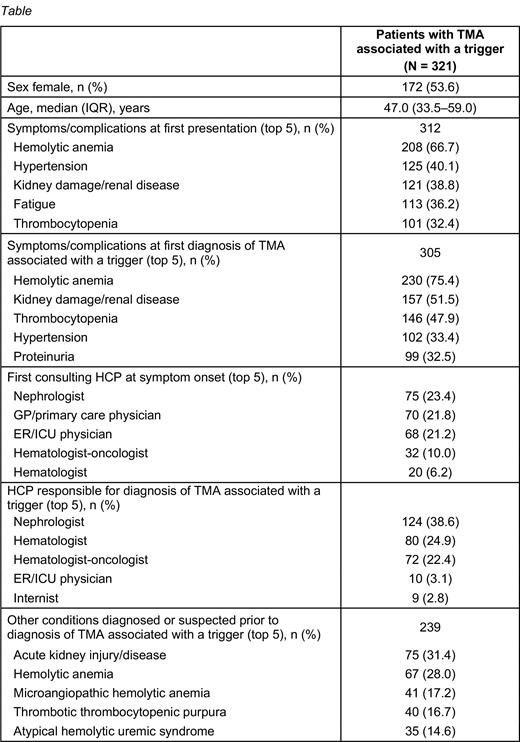Introduction
Thrombotic microangiopathy (TMA) is characterized by thrombocytopenia, microangiopathic hemolytic anemia and microthrombi leading to ischemic tissue injury and organ damage. Disease emergence is unpredictable and in some cases TMA manifests in relation to a trigger, including autoimmune disease, infection, malignant hypertension, pregnancy, transplantation and drugs. In this study, we characterized the patient diagnostic journey of TMA associated with a trigger using real-world data.
Methods
Data were drawn from the Adelphi aHUS Disease Specific Programme, a cross-sectional survey of physicians and their patients with TMA associated with a trigger (data collected August-December 2022) from Australia, France, Germany, Italy, Spain, the UK and the USA. This analysis included physician-reported patient data and all patients had TMA associated with a trigger diagnosed by a physician. Analyses were conducted with all triggers combined, and by trigger type.
Results
Overall, 321 patients with TMA associated with a trigger were included; the top 5 most frequent triggers were infection (19.0%), drug (15.0%), autoimmune disease (14.6%), malignancy (13.7%) and solid organ transplantation (10.6%). Demographics, clinical characteristics and route to diagnosis are provided for all patients in the Table.At the point of survey, 53.6% of patients were female and the median age (interquartile range [IQR]) was 47.0 (33.5-59.0) years. Overall, 7/312 (2.2%) and 16/309 (5.2%) patients had a family history of TMA or kidney disease, respectively, although these proportions were higher in patients with TMA triggered postpartum (2/18 [11.1%] and 4/18 [22.2%]). The most common ethnicity was White/Caucasian (199/280 [71.1%]), however this varied across triggers; lowest in malignant severe hypertension (12/24 [50.0%]) and highest in bone marrow transplantation (21/25 [84.0%]). At first presentation to a healthcare professional (HCP), the most common symptom/complication was hemolytic anemia (208/312 [66.7%]), yet other common symptoms/complications varied across triggers (e.g. 24/45 [53.3%] patients with TMA triggered by an autoimmune disease presented with fatigue, and 17/29 [58.6%] and 14/29 [48.3%] patients with TMA triggered by malignant hypertension presented with kidney damage and proteinuria, respectively). At first diagnosis of TMA associated with a trigger, 125/315 (39.7%) and 44/315 (14.0%) patients had severe or life-threatening TMA, respectively; further, 260/277 (93.9%) patients had a platelet count outside the normal range, 101/115 (87.8%) patients had a lactate dehydrogenase level > 1.5 × the upper limit of normal, and the median (IQR) serum creatinine level among all patients was 2.9 mg/dL (1.8-4.0). Across all triggers, the first consulting HCP at symptom onset was most often a nephrologist (23.4%), general practitioner (GP; 21.8%) or emergency room (ER)/intensive care unit (ICU) physician (21.2%), while the first diagnosing HCP of TMA associated with a trigger was most often a nephrologist (38.6%), hematologist (24.9%), or hematologist-oncologist (22.4%). In 249 patients with available data, the median duration from symptom onset to TMA diagnosis was 6.0 days (IQR, 0-30.0 days).
Conclusion
In this study, severe or life-threatening TMA associated with a trigger was reported at the point of diagnosis for over half of the patients. An increased awareness of the clinical characteristics, symptoms and complications of TMA associated with a trigger by HCPs, particularly GPs who were frequently the first consulting HCP, is key to facilitating early diagnosis and timely referral to TMA experts/multi-disciplinary teams and optimizing patient management.
Study/medical writing support funder: Alexion, AstraZeneca Rare Disease, Boston, MA, USA.
Disclosures
Wang:Alexion, AstraZeneca Rare Disease: Current Employment; AstraZeneca: Other: Shareholder. Gatta:Alexion, AstraZeneca Rare Disease: Current Employment; AstraZeneca: Other: Shareholder . Conyers:Adelphi Real World: Current Employment. Gibson:Adelphi Real World: Current Employment. Wynne-Cattanach:Adelphi Real World: Current Employment. Myrén:Alexion, AstraZeneca Rare Disease: Current Employment. Ong:AstraZeneca: Other: Shareholder; Alexion, AstraZeneca Rare Disease: Current Employment.


This feature is available to Subscribers Only
Sign In or Create an Account Close Modal